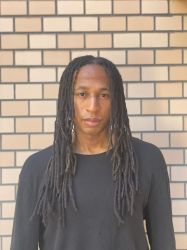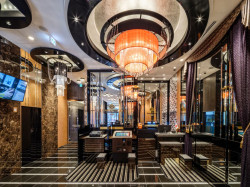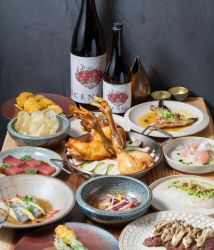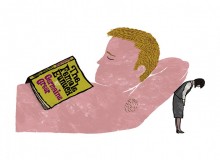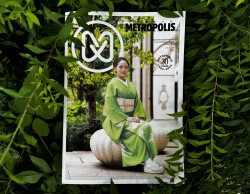
May 19, 2011
Pantheon of Japanese Rock Gods
Metropolis celebrates the Japanese men who rocked the planet
Originally published on metropolis.co.jp on May 2011

Phil Couzens
As a bookend to our Pantheon of Japanese Rock Babes feature (http://meturl.com/rockbabespantheon), we asked a rocker’s dozen (13) seasoned critics of Japanese music to tell us what their favorite rock god means to them.
1. Eikichi Yazawa

Eikichi Yazawa: © ON CO., LTD.
With a record 112 Budokan performances, Eikichi Yazawa may be the most successful Japanese rock singer of all time. Originally the lead singer of Carol, Yazawa launched his solo career in 1975, and at age 61, continues to tour prolifically every year. Fans see Yazawa as a self-made man, the proverbial bad boy who turned his back on social norms and did things his way, rising from poverty to achieve the “Japanese Dream.” To Japanese baby-boomers, he is the embodiment of cool, and remarkably, he has remained so throughout his career. Fans still flock to hear him sing “I Love You, OK” today, just like they did in 1975. Yazawa, often wearing a white suit with shirt buttons undone à la Freddie Mercury, spins his white mike stand like Rod Stewart, and struts the stage like Mick Jagger. But unlike many Japanese musicians, he has somehow been able to fuse these borrowed elements together and make them his own, creating a distinct sound, style, and feeling that can only be described as Eikichi Yazawa.
Isaku Kageyama is a professional taiko musician.
2. Murahachibu
 I name a Kyoto group called Murahachibu, which formed in 1968 and split in 1973. They are my all-time favorite Japanese band, even beating off worthy followers Carol, Guitar Wolf and RC Succession. When legendary ’70s guitarist Char first heard Murahachibu he said, “This sounds like a Japanese Sex Pistols.” What he should have said was, “This sounds like Keith Richards shagging Iggy Pop in a gutter.” Murahachibu’s singer Chabou, who died in 1994 after a life of excess, at age 44, had a guttural howl more terrifying than Iggy Pop and Johnny Rotten. Together with guitarist Fujio Yamaguchi’s killer blues riffs, this was a marriage made in hell—the biggest-ever homegrown influence on Japanese rock. I first heard Murahachibu when 54 Nude Honeys singer Yuri moved in with me. Yuri had this vinyl record with what looked like some New York Dolls wannabes on the cover. It was an original copy of Murahachibu’s best album, Live +1, and when the first track “Ahhh!!” kicked in, I was in love. When Yuri moved out, I hid the Murahachibu record in the hope she’d forget it. She didn’t .Since then I’ve bought every Murahachibu record I can find, but originals are rare, as the band were pretty obscure and never even bothered to record a studio album.
I name a Kyoto group called Murahachibu, which formed in 1968 and split in 1973. They are my all-time favorite Japanese band, even beating off worthy followers Carol, Guitar Wolf and RC Succession. When legendary ’70s guitarist Char first heard Murahachibu he said, “This sounds like a Japanese Sex Pistols.” What he should have said was, “This sounds like Keith Richards shagging Iggy Pop in a gutter.” Murahachibu’s singer Chabou, who died in 1994 after a life of excess, at age 44, had a guttural howl more terrifying than Iggy Pop and Johnny Rotten. Together with guitarist Fujio Yamaguchi’s killer blues riffs, this was a marriage made in hell—the biggest-ever homegrown influence on Japanese rock. I first heard Murahachibu when 54 Nude Honeys singer Yuri moved in with me. Yuri had this vinyl record with what looked like some New York Dolls wannabes on the cover. It was an original copy of Murahachibu’s best album, Live +1, and when the first track “Ahhh!!” kicked in, I was in love. When Yuri moved out, I hid the Murahachibu record in the hope she’d forget it. She didn’t .Since then I’ve bought every Murahachibu record I can find, but originals are rare, as the band were pretty obscure and never even bothered to record a studio album.
Simon Bartz, www.myspace.com/yojimbotokyo
3. Kiyoshiro Imawano
 Best known to this writer as the perennial closer of Fuji Rock—and fellow patron of a favorite Shibuya curry shop—Kiyoshiro Imawano was an unmistakable presence. With a shock of teased hair, makeup and outlandish garb, he expertly blended T-Rex glam-rock swagger with New York Dolls androgyny. Rising to fame as part of RC Succession, which originally formed as the Clover in 1966, the impish Imawano was a raspy-voiced leprechaun who refused to grow old—or grow up. Prancing about the bandstand, he dared you to stay seated or ignore his imprecations—whether you liked his unsubtle rock ‘n’ roll or not. Imawano was also an antinuclear activist and, in the wake of Fukushima, appears prescient. After Chernobyl, he penned a cover of “Summertime Blues” with new lyrics warning of the risks posed by the increasing number of nuclear reactors in Japan. But the album, Covers, was quashed by RC Succession’s label Toshiba EMI, a subsidiary of the same Toshiba Corporation that builds nuclear reactors. The company issued a press release that the record had been canceled because it was “too wonderful to be released.” RC Succession went on to issue Covers from its original label, Kitty Records, in 1988, when it became the group’s only Number One album. In a sign of the reverence with which Imawano is regarded in Japan, more than 40,000 fans turned out for his funeral when he died of cancer at 58 in May 2009.
Best known to this writer as the perennial closer of Fuji Rock—and fellow patron of a favorite Shibuya curry shop—Kiyoshiro Imawano was an unmistakable presence. With a shock of teased hair, makeup and outlandish garb, he expertly blended T-Rex glam-rock swagger with New York Dolls androgyny. Rising to fame as part of RC Succession, which originally formed as the Clover in 1966, the impish Imawano was a raspy-voiced leprechaun who refused to grow old—or grow up. Prancing about the bandstand, he dared you to stay seated or ignore his imprecations—whether you liked his unsubtle rock ‘n’ roll or not. Imawano was also an antinuclear activist and, in the wake of Fukushima, appears prescient. After Chernobyl, he penned a cover of “Summertime Blues” with new lyrics warning of the risks posed by the increasing number of nuclear reactors in Japan. But the album, Covers, was quashed by RC Succession’s label Toshiba EMI, a subsidiary of the same Toshiba Corporation that builds nuclear reactors. The company issued a press release that the record had been canceled because it was “too wonderful to be released.” RC Succession went on to issue Covers from its original label, Kitty Records, in 1988, when it became the group’s only Number One album. In a sign of the reverence with which Imawano is regarded in Japan, more than 40,000 fans turned out for his funeral when he died of cancer at 58 in May 2009.
DG
4. Shinki Chen

©1971UNIVERSAL MUSIC LLC
Shinki Chen is a Japanese rock legend as much for what he hasn’t done as for what he has. Since his 1972 eponymous solo album, the guitar god has given up recording and lived the life of a recluse. What makes this so tantalizing is that when he broke upon the scene he was hailed as the “Japanese Hendrix.” Born in Yokohama in 1949 to Chinese parents, Chen was unusual not only for his looks—tall with cascading Afro hair and a cigarette dangling from his lips (a kind of proto-Slash)—but also for his uncompromising rock ‘n’ roll attitude. Starting out playing folk, he graduated through a Ventures-type surf group before becoming obsessed with The Kinks and The Yardbirds, playing increasingly psychedelic blues-rock between stints in the Japanese version of the musical Hair and periods sleeping rough on the Shinjuku streets. In 1970, with keyboard wizard Hiro Yanagida, he recorded the legendary Food Brain album, then went on to form Speed, Glue, and Shinki, a threesome, where the two other members were nicknamed after their respective addictions. In these various combos Chen’s guitar oozes expressiveness along with the don’t-give-a-f**k attitude that later saw him turn his back on the music business.
C.B. Liddell writes on art and music for Metropolis and The Japan Times.
5. Kazuhiko Kato

Courtesy of Columbia Japan
Originally a member of the Folk Crusaders in the ’60s, Kazuhiko Kato—Tonovan to friends—hit icon status in the ’70s when he teamed up with wife Mika to form the glam-rock-tastic Sadistic Mika Band, a pun on the Plastic Ono Band. It was his ear for melody that stood out on one of J-rock’s all-time classic albums, Kurofune, produced in Kato’s beloved England in 1974. Appearances on the BBC’s The Old Grey Whistle Test (renamed “Gley Whistle” in their honor) and a tour with Roxy Music gave Japanese rock its first showcase to an international audience. Current pretenders Abingdon Boys School paid their dues by booking the same Camden venue as SMB on their 2009 Europe tour. A true gent rarely seen in anything but a slim, smart suit, and an avid collector of antique British memorabilia that filled his stately Tokyo apartment, Kato stayed inventive until the end. He brought in Kaela Kimura for Sadistic Mikaela Band and then paired up for two delightful folk-rock releases with Koji Sakazaki (of The Alfee) as “Kazukoh.” The suicide in 2009 of a quiet man whose musical statements were the peak of Japanese rock’s first golden age was a shock even to close friends.
Robert Michael Poole is director of Something Drastic Artist Management.
6. Friction

© Yasushi Saitama
Japanese punk had quite different origins to the UK scene, emerging organically out of the 1970s avant-garde, underground rock scene rather than in violent reaction against mainstream excesses. Thus, by the time Friction formed in 1978, founding members Reck and Chico-Hige had already been making a noise in and around Tokyo, not to mention during a sojourn in punk-rock central New York, playing in no wave screech-meisters Teenage Jesus & The Jerks and The Contortions. Friction’s early style demonstrated vocal inflections influenced by The Sex Pistols, but veered away from pub rock-influenced guitar chug, preferring instead to slash away at sharp angles, with a scratchy, metallic guitar sound influenced more by the arty New York no wave scene and perhaps by British postpunk acts like Wire. With their background based in the Japanese underground, Friction quickly synthesized their Western influences into a style of their own, and they remain one of the country’s most influential punk generation acts. With their jittery rhythms, wiry frames, and Reck’s Lou Reed shades, their early, black-and-white concert films present a how-to guide for anyone wanting to be a cool young punk. But for me it’s perhaps the film Dumb Numb, directed by punk film veteran Sogo Ishii in 1991 long after most remnants of Japanese punk had collapsed, that captures the band at their defiant, furious, idiosyncratic best.
Ian Martin runs Call and Response Records.
7. Hide

© HEADWAX ORGANIZATION ALL RIGHTS RESERVED
Finding a rock god in Japan isn’t that easy; finding a rock god in the line-up of X-Japan is a piece of cake. The problem is picking just one. In the early days, they all looked like rock gods, with their truly monumental hairstyles, and there is no doubt that leading light Yoshiki is a rock ‘n’ roll legend. But X-Japan has only one immortal presence: the sadly-deceased-but-still-with-us Hide. The band’s guitarist died 13 years ago at age 33—most people doubt the official verdict of suicide—but he lives on. Really. When X regrouped three years ago and played a triumphant comeback gig at the Tokyo Dome, Hide also returned, playing alongside his band mates via spookily synchronised visuals. Age shall not wither his beauty—and Hide was a stunner on stage: massive hair, androgynous clothes, psychedelic guitars and creative makeup (he was a licensed beautician). But even clothes and makeup won’t give you what Hide had in spades: charisma. He loved the spotlight and just seemed to be made for the stage—at times cool and detached, at others wild and abandoned—you just couldn’t take your eyes off him. He may have departed this world, but Hide deserves his place in the pantheon of rock ’n’ roll gods.
Fred Varcoe is a journalist with short hair who still thinks he has long hair.
8. Atsushi Sakurai
 Recognized as one of the founders of visual-kei, Buck-Tick is influenced by the likes of David Bowie, Sisters of Mercy and Bauhaus, and the band has explored a variety of genres including cyberpunk, goth, electronica and rock. Yet, somehow, the band remains true to its own signature sound and its name—a play on the word “firecracker” (bakuchiku). Guitarist Hisashi Imai is the band’s founder and composer, starting it in 1983 out of Fujioka. But it is Atsushi Sakurai who best embodies the Buck-Tick brand. A bad boy in high-school, “Acchan” was first recruited as the drummer, and then went on to become the vocalist and lyricist. Whether sultry, emotionally raw, or electronically distorted, Sakurai’s distinct vocals and even more distinct angry samurai looks have made him an unforgettable front man. Provocative on stage, yet modest in interviews, dressed to the nines in dark haute couture, a cat lover, Baudelaire-admirer, and a bit of a poet himself—what more could a J-rock fangirl’s heart desire? With 18 Buck-Tick studio albums, plus literary, film and solo music projects, as well as numerous collaborations (notably with Raymond Watts and Sascha Konietzko of KMFDM fame) under his impeccably styled belt, Atsushi Sakurai is a true entertainer who only gets better with age.
Recognized as one of the founders of visual-kei, Buck-Tick is influenced by the likes of David Bowie, Sisters of Mercy and Bauhaus, and the band has explored a variety of genres including cyberpunk, goth, electronica and rock. Yet, somehow, the band remains true to its own signature sound and its name—a play on the word “firecracker” (bakuchiku). Guitarist Hisashi Imai is the band’s founder and composer, starting it in 1983 out of Fujioka. But it is Atsushi Sakurai who best embodies the Buck-Tick brand. A bad boy in high-school, “Acchan” was first recruited as the drummer, and then went on to become the vocalist and lyricist. Whether sultry, emotionally raw, or electronically distorted, Sakurai’s distinct vocals and even more distinct angry samurai looks have made him an unforgettable front man. Provocative on stage, yet modest in interviews, dressed to the nines in dark haute couture, a cat lover, Baudelaire-admirer, and a bit of a poet himself—what more could a J-rock fangirl’s heart desire? With 18 Buck-Tick studio albums, plus literary, film and solo music projects, as well as numerous collaborations (notably with Raymond Watts and Sascha Konietzko of KMFDM fame) under his impeccably styled belt, Atsushi Sakurai is a true entertainer who only gets better with age.
Nina Kouprianova blames Japanese pop culture for distracting her from a PhD thesis on a totally unrelated subject.
9. Yamataka Eye

© commmons
With scraggly hair and a raucous character, Tetsuro Yamatsuka is not the best candidate to hustle home and greet sheltered parents. Despite Yamatsuka’s predilection towards changing his DJ and production names, he’s best known as Yamataka Eye, and as a member of Boredoms—one of the greatest noise rock bands in a country equally renowned for Melt-Banana and Merzbow. Formed between 1982-1986 and likely inspired by The Birthday Party and Einstürzende Neubauten, Boredoms have rotated their membership while keeping Yamatsuka in the role of front man. Known for his atypical vocal workouts and post-production prowess, Yamatsuka was a pivotal player in the band’s most enduring album, Pop Tarti (1993), which still stands strong 18 years on. Beyond Boredoms, Yamatsuka also recorded an EP with Sonic Youth (1993’s TV Shit), worked with Bill Laswell’s band Praxis, John Zorn’s Naked City and released two brilliant live LPs in 1995 with experimental composer Yoshihide Otomo (under the underplayed alias of MC Hellshit & DJ Carhouse). Thrown together in disseminated ways, Yamatsuka is a rock kami unto himself—hair awry and all.
Andrez Bergen is a journalist and Japanese music groupie, from noise and taiko through its more dulcet J-pop moments.
10. Cornelius

Courtesy of Warner Music Japan
Keigo Oyamada—known best under nom de musique Cornelius—put Japanese indie music on the map—both in Japan and overseas. Son of famed Hawaiian band vocalist Satoshi Mihara, Oyamada grew up an avid collector of obscure Western music, and right out of high-school signed a record deal for his neo-acoustic act Flipper’s Guitar. The young band ushered in the Shibuya-kei wave of Western-minded domestic indies, introducing an increasingly sophisticated youth to diverse musical influences such as C86, bossa nova, Italian film soundtracks and Madchester. After Flipper’s sudden breakup in 1991, Oyamada kept busy, taking on the Planet of the Apes-inspired moniker Cornelius, releasing hit albums The First Question Award and 69/96, forming seminal indie label Trattoria (home to Citrus, Salon Music, and Seagull Screaming Kiss Her Kiss Her), and doing ads for hair mousse Uno. He did not etch his name in musical history, however, until 1997’s Fantasma—a meta-musical, headphone-optimized concept album that perfectly meshed retro-future visions of the 1960s with 1990s jungle breaks, kitschy sampling, and references to Elephant 6. This reputation of genius later spread overseas thanks to constant touring in the West and some high-profile remixes of pop stars like Beck. In recent years, Oyamada has moved into increasingly minimalist directions with albums Point (2001) and Sensuous (2006), and over the last half-decade has mostly popped up playing guitar for other members of the Japanese music pantheon, such as Yellow Magic Orchestra and Yoko Ono. As a musician, I am grateful to Cornelius’ music for re-defining what was possible for pop music, and as music fans, we can all thank him for championing an innovative stream of Japanese acts whom we would not have otherwise heard.
W. David Marx is Chief Editor of Neojaponisme.
11. Tamio Okuda

© Ki/oon Records Inc
Born in 1960s Hiroshima where he developed a lasting love for the pop sensibilities of The Beatles, Tamio Okuda rose to prominence during the band boom of the mid-’80s, fronting experimental rock-pop five-piece Unicorn. When the band split in 1993, Okuda retained his management deal with Sony, and released the solo albums 29 and 30 in homage to his ripening age. The albums’ blues arrangements and staccato vocal phrases showcased his rich, bruised voice. He soon found himself writing songs for Sony’s fresh-faced new pop duo Puffy (alongside Yosui Inoue), including mega-hit debut single “Asia No Junshin.” Several million sales later, he remains one of Japanese rock’s most affable artists, gamely collaborating with performers as diverse as pop chick Kaela Kimura, underground heroes HiGE and The Who’s session bassist Pino Palladino. The occasional experimental live show and his strong songwriting chops have inspired a whole new generation of Japanese musicians. “If you start out trying to make people laugh, you can go anywhere from there,” he told me when I interviewed him during Unicorn’s 2009 reunion tour—and it is this guiding principal that has made him such an enduring and loveable icon 24 years later.
Daniel Robson writes on Japanese music for NME and CNN and runs monthly event Bad Noise.
12. Guitar Wolf

© Ki/oon Records Inc
Clad in full-piece motorcycle leather and sunglasses, sporting greased hair and rude looks, garage punk band Guitar Wolf has been delivering high-octane performances since their formation in 1987. The group is self-described as “Japan’s Greatest ‘Jet’ Rock ‘n’ Roll Band,” a genre they coined themselves in homage to the sounds of Joan Jett, the Ramones, and the other great hard rock bands of the ’70s. With screaming vocals, loud guitars and Chuck Berry harmonies that meet the metal age, Guitar Wolf takes the archetypal elements of rock ‘n’ roll to the very extreme. Their live show is every bit as intense. Guitar Wolf Seiji has presence unlike any other rock front man. He swings his hips, jumps off amplifiers, windmill-strums his guitar, and sweats up a storm. Guitar Wolf’s vintage aesthetic and indefatigable energy puts the Yoyogi greaser boys to shame. The band has even garnered success in America, touring extensively and attracting the attention of legendary indie rock label Matador Records. For proof of the band’s rock prowess, pick up the 2000 film Wild Zero, a rock flick in which the band fights the onslaught of the zombie apocalypse with nothing other than the deified power of rock ‘n’ roll. I first saw the film when I was a college freshman. I enrolled in first-year Japanese the following autumn.
Ethan Green blogs as An American Werewolf in Tokyo: http://tokyowerewolf.blogspot.com
13. Boris
 I decided it was time to give life in Asia a try at about the same time I discovered Boris. I had just had my mind thoroughly blown by Boris’ album Pink, and as I looked into them more, I figured any place that could produce a band this multifaceted deserved to be explored. Off to Japan I went. Apart from superlatives describing their talent, eclectic is probably the best way to describe Boris. Their first album, Absolutego, was one 65-minute drone song. In the 15 years since their albums have covered a plethora of styles including stoner rock, punk, and psychedelic to name a few. The first of three outings they’ll be releasing this year, New Album once again explores new territory and is jam-packed with J-rock weirdness. The impressive thing about Boris for me is that, in spite of the many stylistic changes and extremes their music goes to—from single-chord drones to head-banging rock anthems—it’s always engaging. It’s a shame that Boris doesn’t get more attention here in their home country, because not only is this band willing to try nearly anything with their music—they are also able to make it work.
I decided it was time to give life in Asia a try at about the same time I discovered Boris. I had just had my mind thoroughly blown by Boris’ album Pink, and as I looked into them more, I figured any place that could produce a band this multifaceted deserved to be explored. Off to Japan I went. Apart from superlatives describing their talent, eclectic is probably the best way to describe Boris. Their first album, Absolutego, was one 65-minute drone song. In the 15 years since their albums have covered a plethora of styles including stoner rock, punk, and psychedelic to name a few. The first of three outings they’ll be releasing this year, New Album once again explores new territory and is jam-packed with J-rock weirdness. The impressive thing about Boris for me is that, in spite of the many stylistic changes and extremes their music goes to—from single-chord drones to head-banging rock anthems—it’s always engaging. It’s a shame that Boris doesn’t get more attention here in their home country, because not only is this band willing to try nearly anything with their music—they are also able to make it work.
Kevin Gillich—when not at a local rock concert—teaches English in Kanagawa so he can afford to go to more shows.

